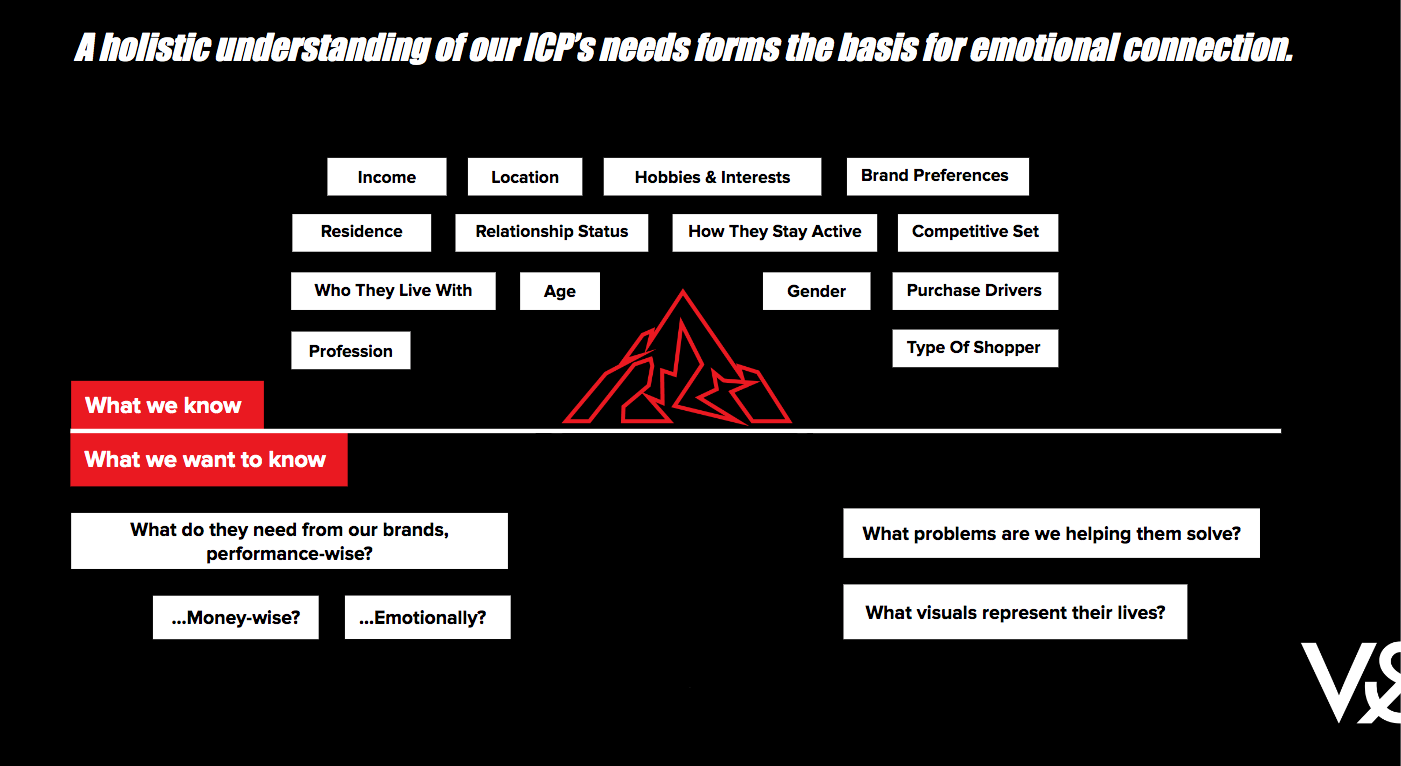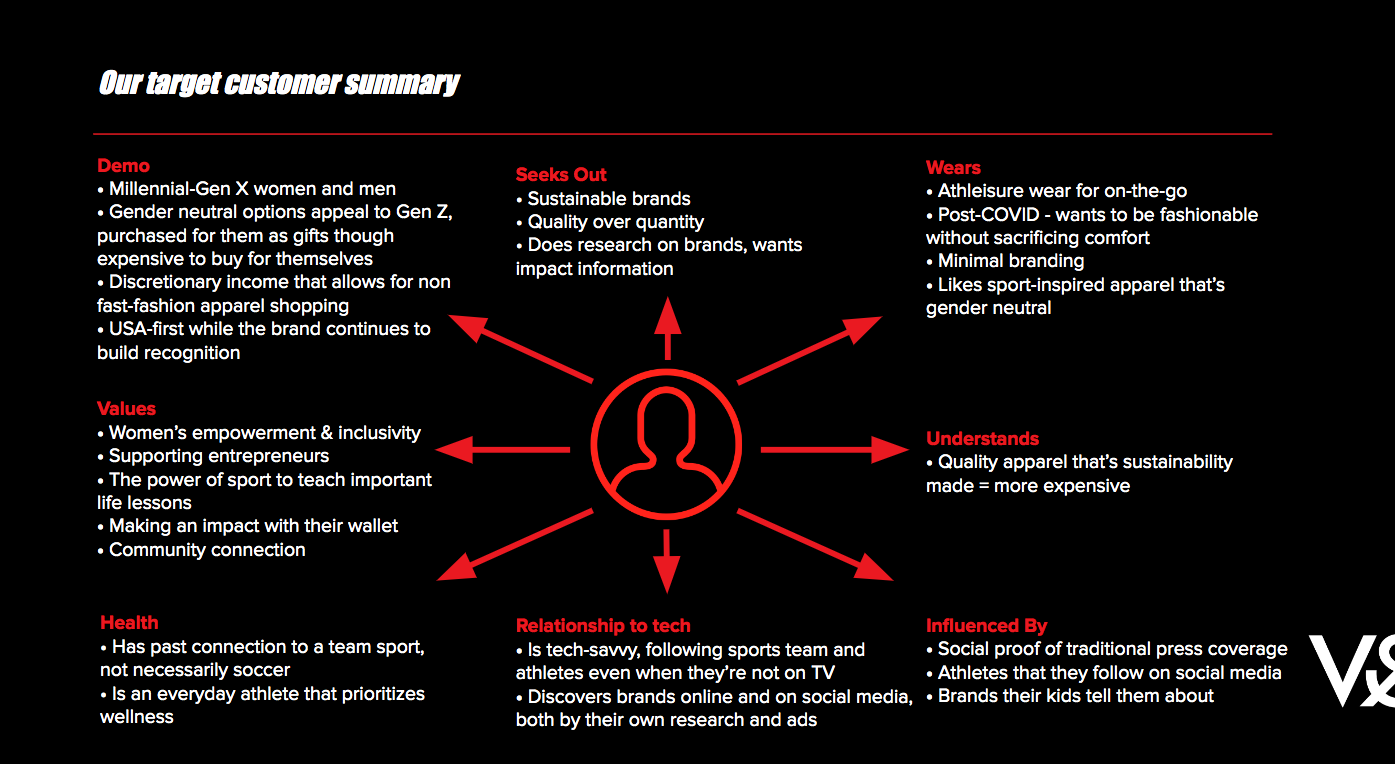Leverage Ideal Customer Profiles (ICPs) And Personas To Win
5 FROM THE VINE
- ICPs and Personas help rally teams – namely product, sales, and marketing – to solve your customer’s pain points and endear them to your brand.
- ICP and Persona development is instrumental to successful brand building, positioning, and go-to-market. The earlier you can start, the better.
- ICPs are informed by data, but aren’t dependent on it. Use data in combination with empathetic listening, stakeholder conversations, and market research.
- Personas emerge from observation and insightful questions drawn from ICPs. Understand how your customers live, feel, and approach work, life, and scenarios relevant to your brand.
- ICP and Persona development should yield a high ROI. Knowing who you’re targeting will yield notable dividends from paid social and customer acquisition efforts.
Imagine your team is preparing to ramp up investment on paid performance and doesn’t know who they’re trying to connect with – or worse – why.
It’s not just about the product you want to sell. It’s about who you want to connect with, when you’ll win their attention, and what platforms they’re most engaged with. It’s about articulating why they should value your solution over a competitor, and showcasing your solution with the right visuals and messaging so they notice you.
Unfortunately, many teams are operating in the wrong way. Instead of answering the above questions they start creating a bunch of ads on the channels they’re most familiar with, publishing landing pages with creative and copy that speak to the needs they think are most important.
Any action taken by a marketing team that’s not grounded in strategy is money flushed down the drain. Who is your target customer? Why are you connecting with them?
This is where Ideal Customer Profile (ICP) and Persona development comes in.
ICPs and Personas: What’s The Difference?
Before we go any further let’s get these two clarified, as they’re not the same thing.
What is an ICP?
ICPs represent the “type” of customers you’d like to win, often based on your current highest value customers. They’re made up of characteristics or qualities, rather than descriptions of specific individuals.
For example, if you’re a Canadian healthtech brand, your ideal customer might be 35+ year old suburbanites that have a household income above $90k.
What are Personas?
Personas are grounded in real people you can empathize with in terms of their challenges, motivations, the products they’ve tried in the past (good and bad), the tradeoffs they make, and their hopes and fears.
Your customer personas narrow your ICPs down further, allowing you to target people like Olivia the Optimizer – a mother of a child in daycare that prioritizes their health alongside her career and family, and looks for the highest ROI workouts and supplements so she can sustain her care for others.
If you’re ever feeling stuck on whether you’re asking ICP-related questions or Persona-related questions, check out the visual below.

Above the white horizontal line are ICP attributes and below are Persona attributes. See how the questions below the line aim to draw insights from those presented above. Understanding what your Personas need and the problems you’re helping them solve helps you speak to them.
Complement this with visuals they resonate with and you’ll be taking great strides to creating actionable ICPs and Personas.
Together, ICPs and Personas define a brand’s most valuable customers. They don’t just capture their demographics, but their essence and motivators. It is as important to your business as it sounds, and will help you focus and grow.
It’s important to note that ICPs and Personas are relevant to both B2C and B2B companies. For B2C companies, it’s people. For B2Bs, your ICPs are types of companies that will be a great fit for your offering – like tech startups and scaleups. Personas will be the roles of individuals within those companies, like HR Heather or VC Vikram.
All of this is simple enough, but can you believe many companies never define their ideal customer? You can use this to your advantage, because once you define your ICP you will have a significant marketing advantage.
ICPs, Personas, and Challenger Brand Strategy
By nature, Challengers are in the business of solving customers’ pain points in a way that is better socially and environmentally. Starting with ICPs and Personas helps you focus your messaging and marketing dollars to reach and build a relationship with a core group of customers that are foundational for growth.
When you know the core problems you’re solving and for who, you’ll have the basis of the job you’re going to be hired by your customers to complete. With that, you’ll also be able to identify where your competitors fit and how you can use a Challenger mindset to outsmart them.
5&Vine often begins its work with ICPs and Personas as the basis to develop:
- Value propositions, positioning statements, and brand manifestos
- Brand archetypes
- Brand guidelines to define tone of voice
- Selection of the right paid channels
- Organic content and social strategies
- Community advocates
- Influencers and strategic partnerships
- Sales funnel optimization
- Product development prioritization
In essence, defining your Personas is foundational. From there, the potential impact is immeasurable.
Creating Your Own ICPs
Start with the basics
To get to Personas, we always start with ICPs. Review your current customers and highlight your top 5-8 who you’d like to replicate if you could. If you don’t have many customers yet, think about the customer you’d like to attract.
To do this effectively, it’s important to have both quantitative data from multiple sources like Google Analytics, Shopify, SEMrush, etc. Start by looking at basic details, such as:
- Who are your most profitable customers? Of those, which did you love working with or helping solve their needs?
- Which of these were one-time versus repeat customers?
- Where did they come from? Paid ad, organic traffic, referral, in-person connection?
- If paid or organic, did they come through mobile or desktop?
- Where are they located?
- Which product/service line brought them in?
- What customers have the highest satisfaction levels?
Don’t just rely on owned quantitative data. Look for insight from your team and industry too. For example:
- Insights from customer-facing employees, in-field sales team members, and other key decision-makers such as sales or marketing heads.
- Data provided by your CRM system and customer support logs. Which company/product did they switch from? What is positively and negatively impacting your Net Promoter Score (NPS)?
- Industry-related reports that provide relevant benchmarks.
Take note of the competition
All Challengers thrive on understanding what their competitors are doing so they can innovate accordingly. By reading your reviews and comparing them to your competitors, and seeing how their consumers engage with them, you may uncover other insights to inform your ICPs and Personas.
Practice social listening
Social media can add even more texture to your ICP and Personas. See who follows and engages with you on social media, look at who they follow and where they spend their time online to create a better picture of who aligns with your brand. Pay particular attention to the brand sentiments they express, both about you and your competition, to help you understand how they’re using your product or service in real life.
Talk to stakeholders
In developing your ICP, talk to your stakeholders. Make the most of their diverse expertise and view of the business to get a rounded sense of who you feel pairs themselves with your business.
List out the customer types you’d like to attract
When you’ve done the above, turn it into a functional, working document that can be shared with teams across your organization. Use it to clarify who your target is, what problems they are trying to solve, and what they value.
Here’s a high-level preview from a DTC Challenger Brand client as an example to see where the above questions will guide you.

Notice how the above sets general parameters for who the ideal customer is and what they value. At this stage you’re ready to take your effort further for personas.
Creating Your Own Personas
Analyze your data to go deeper
It’s time to get under the surface. What products sell best? In what sizes and formats? What products or services are they most often purchased with? What types of content are people interacting with most? What are the common complaints and praise your customer service teams receive, and how has this changed over time? What does this tell you about your customers?
In our scope of work for a Challenger client, we fleshed out the target to get a holistic view of its ICPs. Our goal was to get to the root of three main questions:
What core problem or challenge do they face that we are the antidote for?
What do customers need from the brand, emotionally, personally, and in terms of performance?
What does a typical day in their life look like? When are they at their best, their worst, and what is the role of our brand in helping to resolve some of those tensions?
By answering these questions you’ll start to see Personas emerge.
Create fictional people from your ICPs
An effective way of getting into the mind of your customer, and truly understanding the challenges they face and opportunities they’re looking for, is to create fictional people from your ICPs.
When you do, get to the heart of who they are as people. What drives and inspires them? Why do these fictional people choose your business?
Create 3-5 Personas based on company size
When you have all of this you can create your Personas. We would advise creating at least three, and up to five if you have a larger business with more categories of products/services.
Here’s the kind of details that are helpful to summarize in one slide for easy reference:
Persona name
- Age, gender (if applicable), and location
- Profession
- Location
- Family life
- Relationship with your category (i.e. how they stay active, how they bank currently, how they shop for groceries)
- Goal they’re working towards
- Competitors in their consideration set
- Top 3 problems your brand will help them solve
- A paragraph overview of their life
- A quote about what they need most from your brand
Notice how we include the “top problems to solve” and quotes from their perspective. We believe this is most helpful and actionable to inform marketing teams in their decision-making.
Rinse and repeat
If the last two years have taught us anything, it’s that consumers change. Your business needs to change too. You’ll come to a point where you’ve ‘completed’ your Personas and ICPs but make sure you revisit and update them regularly.
At the beginning of COVID, we published “Everything About Your Challenger Brand Is Being Called Into Question, And That’s A Good Thing” discussing how consumers are reevaluating what gives them meaning and how they’re looking at brands through the same lens.
During, and even beyond COVID, it’s helpful to go back to your Personas and ask:
- How have your customers’ lives changed?
- How can/is your brand helping speak to that change?
- How can your brand help in new and better ways?
In conclusion
ICP and Persona development is the beginning of an actionable plan to prioritize which customers matter most, how you can deliver for them, speak to them, build loyalty and advocacy.
It’s a resource that should be shared internally, with all teams, to ensure everyone’s on the same page.
At the end of ICP development you should be clear on why your customers are trusting you with not just their wallets but their time and energy, and you should be able to better speak to and solve their problems.



